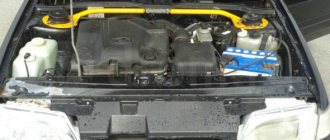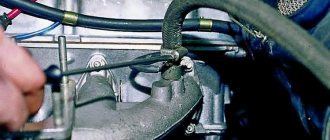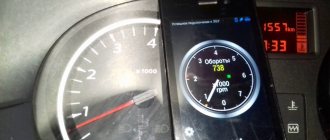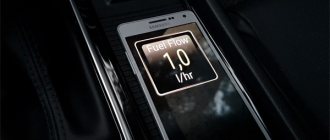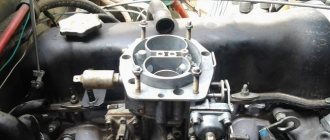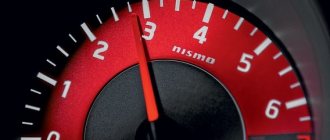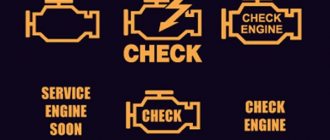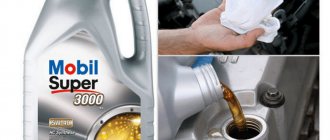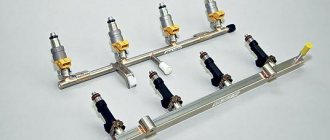Good afternoon Drivers!
Problem... In neutral (sometimes) the rpm is about 500-550. And sometimes normal. Same story on D. The book says that it should be 750-850. I’ve already cleaned the throttle, cleaned the idle sensor, it’s not bitten... In general, there are no complaints about the throttle... Sometimes the speed can be normal all day (you stop at a traffic light) and remain normal. The next day they can drop to 500 when stopping at the same traffic light)) When I stop, I switch to N (so that the gearbox rests). Engine 4A. I just don't know where to dig. The armor wires are new (original), before changing the armor everything was 1 to 1. They turn out to be excluded...
It’s just that if you increase the speed by tightening the bolt on the throttle sensor, I’m afraid that this will not get rid of the problem... because The revs are not always low... Any thoughts?
Many motorists have experienced the effect of a drop in idle speed on their car. Often, this leads to the engine stalling altogether. This effect has many causes that need to be addressed urgently so as not to cause even bigger problems.
What if it's a carburetor?
On older cars with a carburetor intake system, with such symptoms, the automatic throttle fails. This element “sinks” or is poorly adjusted. If the VAZ-2106 stalls at idle, the malfunction may be accompanied by a leak from the vacuum hoses near the base of the carburetor. Problems in the cooling system should not be ruled out. If the car stalls at idle, check the thermostat. If the valve is faulty, the mechanism does not allow the engine to quickly warm up to operating temperatures. In the summer, the car often boils.
Main injector malfunctions
- Coolant temperature sensor malfunction. Interruptions in the operation of this sensor lead to the fact that the engine constantly operates at high speeds, in warm-up mode. At the same time, after the power unit warms up to operating temperature, the electronic control unit does not reset the speed to normal values, since the sensor signals that the engine has not yet warmed up. The same thing happens when the idle air regulator is not functioning properly.
- Throttle adjustment cable stuck. This happens especially often on cars with high mileage.
- Malfunction of the idle regulator or its electronic sensor, in which case the idle speed may increase or disappear altogether.
- Throttle position sensor malfunction.
- Jumping or excessive stretching of the return spring, which should return the damper to its original position.
- Damage to the integrity of gaskets, rubber seals of injectors or the manifold itself. With these problems, excess air from the environment enters the combustion chamber.
The most common reason that the engine speed does not drop to idle when releasing the gas may be careless placement of a mat under the accelerator pedal after visiting a car wash.
Details about the intake system
Since the engine needs not only gasoline, but also oxygen to operate, problems with speed concern the intake air manifold. Such troubles occur due to air leaks in the place that comes after the filter. As a result, the air flow meter sensor is not able to control the process, and the car stalls at idle.
The injector is often equipped with a mass air flow sensor. You shouldn't ignore it. Often this sensor becomes dirty after 100-150 thousand kilometers. It cannot be repaired - only replaced. This part is inexpensive, but it is precisely because of it that in most cases the idle speed fluctuates. The engine also stalls due to the fuel injectors. It is worth checking the condition of the injector. If it is clogged, the crankshaft speed will be unstable. Different amounts of the combustible mixture enter the combustion chamber, which contributes to the incorrect operation of the internal combustion engine.
Main injector malfunctions
- Coolant temperature sensor malfunction. Interruptions in the operation of this sensor lead to the fact that the engine constantly operates at high speeds, in warm-up mode. At the same time, after the power unit warms up to operating temperature, the electronic control unit does not reset the speed to normal values, since the sensor signals that the engine has not yet warmed up. The same thing happens when the idle air regulator is not functioning properly.
- Throttle adjustment cable stuck. This happens especially often on cars with high mileage.
- Malfunction of the idle regulator or its electronic sensor, in which case the idle speed may increase or disappear altogether.
- Throttle position sensor malfunction.
- Jumping or excessive stretching of the return spring, which should return the damper to its original position.
- Damage to the integrity of gaskets, rubber seals of injectors or the manifold itself. With these problems, excess air from the environment enters the combustion chamber.
The most common reason that the engine speed does not drop to idle when releasing the gas may be careless placement of a mat under the accelerator pedal after visiting a car wash.
Filters
After a mileage of 10 thousand kilometers, it is necessary to change the air filter. It is located in a plastic or metal case (on injection and carburetor engines, respectively). If this element looks like the one in the photo below, it should be replaced.
But not only the air is purified in the system. Pay attention to fuel filters too. On diesel engines they are changed every 15 thousand kilometers. As for cars with gasoline engines, they are serviced once every 50 thousand. The throughput of these elements is 10 microns. If low-quality gasoline or diesel was used, the insides of the filter quickly become clogged. There is porous paper inside.
If there is a large amount of dirt, the element is no longer able to clean the fuel. As a result, the car does not hold idle speed and stalls. Even the fact that the pump operates under high pressure does not help. If the filter is heavily clogged, it must be changed immediately. Signs of replacement are also power losses and dips in dynamics.
Let's sum it up
First of all, a malfunction of the injection and carburetor power systems should begin to be diagnosed by inspecting the throttle valve.
In the case of an injection engine, computer diagnostics will help to accurately determine the malfunction of a specific sensor. To do this, it is best to use the services of a service that specializes in servicing cars of a specific brand.
High engine speeds at idle, in addition to completely unnecessary excessive fuel consumption, also interfere with driving the car - for example, when driving through a particularly rough section of the road, when you want to carefully “sneak” among potholes in first gear, and the car boldly takes blows to the suspension. In addition, during long periods of idle time in traffic jams, the engine will always operate at elevated temperatures. Let's look at several reasons why high idle speeds do not drop on a warm engine. The reasons may be malfunctions in both the mechanical and electronic components of the engine power supply system, so we will describe possible failures separately. But since in a car these components interact in a complex manner, you may be able to independently find the answer to the question of why your engine has high idle speeds, taking the material in this article as “food for thought.”
Checking the intake manifold for leaks
Excess air leakage can cause high idle speeds. Moreover, depending on where excess air penetrates into the intake manifold, the idle speed will either simply be increased or begin to “float” - .
If the idle speed “floats”, then most likely this is the case.
If there is simply a violation of the tightness of the intake manifold gaskets, damage to the vacuum hoses or sealing rings, then the speed will “float”. This happens due to the fact that the amount of gasoline supplied to the cylinders will be constant, and the quality of the mixture becomes either “richer” or “poorer”. When a certain critical value (air content in the fuel mixture) is reached, the engine will begin to slow down - until it stops. But as the speed decreases, the amount of air entering the manifold will decrease, i.e. the mixture will become richer and the engine will “come to life” - the idle speed will increase. This will continue until the leak in the intake manifold is eliminated. On turbocharged engines, air leaks can also occur through damage to the intercooler or air pipe connections. If there is significant suction (for example, if the pipe has come off the intercooler), the engine begins to operate with a whistling (or hissing) sound. But sometimes it is possible to identify the location of a violation in the intake tract only by cutting off the air supply to the intake manifold in different places in turn - from the air filter to the manifold itself.
Difference between carburetor and injection filters
It is worth noting that the pressure levels in these intake systems are different. For injection engines it is many times greater. Therefore, when purchasing new fuel filters, you should check with the seller which engine you have. This is especially true for cars on which different types of systems were installed (for example, old and new “tens”).
If you put a filter designed for a carburetor on an injection engine, it simply will not withstand the pressure. All dirt will end up in the pump injectors. They get clogged, so the engine stalls at idle. As for air filters, they are very easy to distinguish. In carburetor engines they have a round shape.
Electronics failures
Checking the engine idle speed control
After replacing the idle air regulator, it must be “registered” i.e. enter its parameters into the ECU memory.
The idle air control (IAC) is a stepper motor (solenoid) powered by pulse signals supplied. It works in a similar way to the screw for adjusting the amount of mixture in the carburetor - when the valve extends, it closes the fuel channel, and when it moves back, it opens it. It often happens that the regulator core simply jams and it stops responding to ECU signals. Moreover, you can damage the idle air regulator even in the store when purchasing it - by trying to turn or press the valve needle with your hands. If after replacing the idle speed sensor (regulator) there are high speeds, then most likely the problem is either in the ECU or in the mass air flow sensor - all the elements that make up the power system work in interaction, and diagnostics need to be carried out. It is quite possible that you will have to “register” a new regulator - that is, enter its parameters into the ECU memory.
temperature sensor
This sensor can also affect the engine fuel system. By issuing an incorrect signal (corresponding to a low temperature) to the ECU, it will cause the controller to give a signal to other elements of the fuel system (including injectors) that the mixture is enriched. An incorrect sensor signal will result in idle speeds exceeding 1000 min-1.
Mass air flow sensor
The mass air flow sensor directly affects the quality and quantity of the mixture supplied to the cylinders - after all, the ECU “knows” about its composition thanks to this (and some other) sensors. In conclusion, if your car’s engine has increased idle speed for no reason, first look for the cause in possible jamming of the fuel system mechanisms - after all, they are the ones who are primarily exposed to various contaminants, and for electronic components, power surges or short circuits are much more dangerous.
Owners of front-wheel drive VAZs have enough troubles throughout the entire operation of the car. One of the most annoying is high idle speeds, moreover, on an already warmed-up car. This problem usually causes annoyance because there are too many reasons for its occurrence, and finding them is not easy.
Let's list them.
- The most basic is a malfunction or failure of the mass air flow sensor.
- No less common is the breakdown of the idle air control valve.
- A crankshaft position sensor providing incorrect information to the control unit can also be the root cause of a high or floating idle.
- The throttle position sensor may also be to blame.
- It happens that for some reason the gas pedal does not return all the way back. Moreover, this happens both because of a banal malfunction of the cable, and because of something completely ridiculous - for example, after washing the car, they covered the driver’s mat in such a way that the tip of the mat began to touch the pedal.
- The air filter is very clogged. Because of this, the combustion mixture is too rich in gasoline, again resulting in high idle speeds.
- The cable came off the throttle valve.
- Engine temperature sensor faulty. It gives the car’s “brains” incorrect values, which increase the crankshaft speed, thinking that the engine is cold.
As you can see, we have before us a whole forest of very different reasons why high revs appear! Next, we will take a closer look at the most typical, plus the most common problems associated with the problem described. At the same time, we’ll figure out how to eliminate them with our own hands.
"Zuleviki"
If your car uses a zero-resistance filter, if it is heavily contaminated, it can cause problems with the engine. But the cost of such a cleaning element is 7-10 times higher than that of conventional ones. Therefore, special sprays are used to clean them. Filters are processed every 10 thousand kilometers. After applying the composition, you should wait until it is absorbed and rinse the “nulevik” with water for 5 minutes. Dry it thoroughly before installation. Otherwise, when starting, the machine will experience a hydraulic shock.
Pumps
If the car stalls at idle, the reason may lie in low pump pressure. On injection engines it is submersible and is located in the fuel tank itself. On carburetor engines, this element is located separately from the tank and is of the mechanical type. This pump is driven by a handle. It is this that creates the required pressure in the system. But if the fuel line is clogged, the submersible and mechanical pumps do not operate at full capacity. As a result, the car stalls at idle.
If the car does not start at all, it is worth checking the power to the element. Look at the fuses and relays. If on an injection engine the pump does not hum when you turn the ignition key, it means there is no power going to it. On passenger cars it is located in the rear of the passenger compartment, on the right (under the passenger sofa). If it is a diesel power unit, it is worth checking the high pressure fuel pump. At subzero temperatures, paraffin—frozen particles of diesel fuel—accumulates in it. There are problems with starting the engine, the speed often “floats”. Mechanical failure should not be ruled out. The cam drive may have failed.
Why do engine speeds drop?
Poor quality fuel
Very often, the reason for a drop or floating in engine speed lies in poor fuel. If you refuel at different gas stations, then you have noticed the difference in the quality of fuel. Everyone knows that in the countries of the former USSR, owners of gas stations like to skimp on gasoline. Because of this, your car's engine suffers. And if the gasoline is of poor quality, problems with the fuel system may arise. Try refueling your car at another gas station and compare: if there is no difference, then continue reading the article further.
Malfunction in the fuel supply system
Due to low-quality fuel, some elements of the fuel system may stop functioning normally. Try changing the fuel filters, this may help. If this does not help, then you will have to inspect the fuel system.
The problem may also be uneven fuel supply to the cylinders. In this case, you should go to a service station, where a specialist will fix the problem. Do not try to do this yourself: your actions can damage the injector.
It's worth checking the pressure in the fuel rail: connect the pressure gauge, write down the results and compare them with the acceptable results that should be in your car's owner's manual.
The problem could also be with the fuel pump. It may pump fuel unevenly, and because of this, engine speed may drop.
Malfunction in the gas distribution mechanism
Over time, the operation of the gas distribution mechanism may be disrupted. You will have to re-align the gas distribution mechanism according to the marks. It may even come down to cleaning the valves and intake manifold from carbon deposits. If the engine has not been repaired for a long time, quite a lot of carbon deposits can form in the manifold.
Malfunction in the air supply system
A problem with the air flow sensor can also be the reason for the drop in rpm. In order to check it, connect the positive contact of the tester to the yellow wire that goes to the sensor, and the negative contact to the battery. The voltage should be between 0.98 and 1.02 volts.
The malfunction may also lie in the oxygen sensor or in the engine temperature sensor, which calculate the number of revolutions when the engine warms up. Another problem could be different compression levels in the engine cylinders. Due to uneven compression, the engine begins to run unevenly.
Catalytic converters
With the increase in environmental standards, so-called particulate filters began to be installed on diesel cars, and catalysts on gasoline cars. They are designed for a certain service life (about 150 thousand kilometers). Over time, the core becomes clogged. The device cannot produce normal release and purification of exhaust gases.
The way out of this situation is to replace the catalyst with a flame arrester and reflash the electronic unit. But at the same time, the emission standards of your car will drop to Euro-1 values. In the countries of the European Union, the operation of such vehicles is prohibited. But if you drive mainly in the CIS, this is the most optimal solution to the problem. After all, the cost of a new catalyst and particulate filter starts from 40 thousand rubles.
Let's sum it up
There are dozens of types of breakdowns that lead to a sharp or gradual drop in speed on carburetor cars. But the question is that the equipment turns out to be quite demanding in terms of maintenance, so all the reasons have to be eliminated together. If you always encounter such a problem, it means that this is a specific operation of the carburetor installed in your car. Most likely, only replacing the device will help get rid of the troubles. If the problem only occurred a few times, you should try servicing the fuel system, replacing the filter and installing a new carburetor repair kit.
Cars with this type of injection are gradually giving way to injection systems. They are more reliable, more economical, last longer and do not cause such troubles as carburetors. Of course, there are also many subtleties and features in direct injection that should be kept in mind. But changing a carburetor to an injector is too labor-intensive and expensive. It is better to properly maintain your equipment and ensure its normal operation. Even with very good service, after 1-2 years you will have to go to the service again. Have you ever experienced a sharp drop in engine speed when warming up?
Recirculation valve
The car may stall at idle due to malfunctions in the exhaust gas recirculation system. During computer diagnostics, error “P1406” will appear on the screen. It indicates that the valve is “stuck” in the open or closed position. The car stalls at idle and exhibits weak dynamics at high speeds. Over time, plaque accumulates on this valve. The element should be dismantled and cleaned. But if the symptoms recur after re-installation, only replacement will help.
Ways to eliminate the “sore”
If such a problem occurs, you need to look for which node is to blame analytically, checking all the specified sensors.
First, let's consider the following option for correcting the problem situation. Let's assume that a VAZ 2110 has high revs. An examination of the suspected components for faulty components showed that the throttle position sensor has traces of rust. It is located directly above the throttle valve. Measurements with a voltmeter showed that when the engine is idling, the voltage on it remains high - which means it does not close the damper.
How to fix the problem? For this we only need a screwdriver. Let's begin the procedure.
- By disconnecting the terminal block and also unscrewing two screws, we dismantle the assembly.
- We notice that traces of rust inside interfere with the movement of the wheel that regulates the position of the damper.
- We fill the insides of the defective device with a penetrating anti-rust aerosol.
- Use a development screwdriver to turn the wheel.
- We reassemble in reverse order.
Check to see if the engine idle speed is now high. The problem should go away.
Now let's look at another case. Let's say we have high idle speed in a VAZ 2114. This is what we do when faced with this situation.
When clarifying the circumstances of the problem under investigation, we always initially check the operation of the idle speed sensor. This device consists of a needle built inside an electromagnetic coil.
The needle either moves inside the coil, moving away from the hole in the throttle pipe, or moves out, closing this hole, thereby stopping the supply of air for combustion of the mixture.
Also read about and. This element is located at the throttle valve, opposite the gas pedal cable. To diagnose it, we pull out the terminal block from it, start the car, after which we see that we still have high engine speeds that have not changed at idle. Then we remove this defective unit, then clean it or replace it. For work we take:
- screwdriver;
- toothbrush;
- petrol.
Begin.
- Unscrew the two screws. We take out the broken node.
- We connect the wiring to it. Turn on the ignition. If the needle of the device moves slightly inside the coil to the touch, then it is working.
- If the needle does not react when an electric current is applied, wash the device with a toothbrush using gasoline.
- We do the assembly in reverse order.
When you cannot restore the functionality of this unit with your own hands, it is better to purchase a new one. Moreover, the cost of spare parts is low.
Other fixes
Of course, the options considered do not exhaust the possible ways to correct the shortcoming when high speeds are noticed precisely on a warm engine. To further study the most common situations, let's look at the case of a malfunctioning mass air flow sensor. This device is responsible for supplying the correct portions of air for combustion of the mixture, and also provides data to the electronic control unit about these portions, so that the unit proportions the supplied portions of gasoline.
This node can be diagnosed as follows. It is necessary to disconnect the terminal block from our mass flow regulator, and then start the engine, after which it is necessary to drive the crankshaft speed above 2000 rpm.
In this case, the emergency mode is automatically launched, portions of the mixture are now calculated only by the position of the damper. If the sensations show that the car with the disconnected sensor has become more dynamic than with the connected one, then the malfunction of this unit is obvious.
To replace it, take the following tools:
- Phillips screwdriver;
- flat screwdriver.
We are starting renovations.
- After turning off the engine, disconnect the wires from the mass air flow sensor.
- Loosen the clamp and remove the hose on the inlet pipe.
- We dismantle the defective device by unscrewing two bolts.
- We are replacing the device.
- We do the assembly, moving backwards point by point.
This is how this cause of high revs is eliminated.
For some reason it didn't help
Now let's look at another situation. The car owner changed, for example, the idle speed sensor, and the crankshaft speed became high, or remained high as before.
The reasons for this unpleasant phenomenon may be as follows.
- Most likely, the car enthusiast made the replacement just like that, at random, maybe it would stop turning too quickly. The real state of affairs suggests that the fault needs to be looked for elsewhere.
- If this sensor is not a completely new model, it has an adjusting bolt, it may need to be tightened in order to adjust the problem unit. Modern idle air valves do not require any additional adjustment when installed. However, for example, if the Priora has high idle speeds, then you can look for the adjusting screw on this car.
- It is possible that the new spare part was defective.
- The new spare part was installed incorrectly.
Here, perhaps, all the roots of the phenomenon are listed.
Absolute pressure sensor
This mechanism measures the vacuum in the manifold to adjust the amount of mixture supplied. A faulty element misleads the engine. The ECU thinks that the engine is operating under much less or more load than it actually is. Thus, the control unit removes a certain amount of fuel. The car starts to stall. The way out of the situation is to replace the absolute pressure sensor. So, we found out why the car stalls at idle.
Such a problem as engine stalling at idle speed is familiar to many car enthusiasts, whether they are owners of old VAZs or owners of modern foreign cars. And even if the car then starts up as if nothing had happened, and the engine runs stably, such a problem must be solved immediately. True, there may be several reasons for this behavior of the “iron horse”.
If the car does not idle, the parts are probably dirty
How to find the cause of the problem
If the speed of the VAZ 2114 drops, you need to comprehensively diagnose the functioning of the injection system on your car, which can be done in your garage if you have a little experience and appropriate instructions. In this case, those “fourteeners” that were equipped from the factory with a dashboard from the German manufacturer VDO have an important advantage, since it, in comparison with the analogue from Schetmash, is equipped with a self-diagnosis mode.
To carry out this procedure, you will need to perform a few simple steps:
- After turning off the engine, you need to keep the odometer button pressed for three to five seconds;
- Having turned the engine ignition to the first position, the button must be released;
- arrows should appear on the display, which is a signal of normal operation, then the button must be pressed the first time (displaying the firmware version) and the second time - after this probable errors in the ECU will be shown;
- To reset the error message, you will need to hold the button until a zero appears on the display.
After reading the manual, you can find out what errors shown on the screen may be associated with the fact that the speed constantly drops when the gas is released on the VAZ 2114.
So, it could be one of the following situations:
- code 1 – controller error;
- code 14/15 – coolant sensor error;
- code 22/23 – throttle position sensor error;
- code 33/34 – mass air flow sensor error;
- code 42 – faulty ignition;
- code 44 – fuel mixture is lean or too rich.
The owner of a VAZ 2114 should remember a specific feature of the self-diagnosis mode on his car: if there are several errors, the computer sums their codes arithmetically, which can be misleading. This can be indicated by a logical discrepancy between the displayed code and the actual problems.
To be completely sure, you will either need to take the car to a service center and pay for its inspection, or buy a diagnostic scanner yourself, which is not that expensive. Another option is if you have the same VAZ model (fully operational), one by one, remove it from it and install potentially vulnerable sensors on your car, using the method of elimination to find the problem.
Why does the car stall at idle?
Almost always, if a car does not idle and stalls, we are dealing with some kind of breakdown or contamination of parts. Here is an incomplete list of possible causes of engine stalling:
- malfunction of the idle speed controller;
- clogging of the throttle valve, carburetor channels, injector;
- contamination of the idle fuel jet;
- contamination of the fuel pump, fuel filter, air filter;
- failure of the mass air flow sensor, throttle position sensor;
- clogging of the engine crankcase ventilation system.
Video lecture on the reasons for floating idle speed
Causes of car stalling at idle
The car stalls while driving reasons
Drivers often encounter problems with idle speed. It happens that the driver begins to warm up the engine before driving and notices that at first the idle speed fluctuates, and then the car completely stalls. Why does the engine stall at idle? For a carburetor, these are some reasons, but for an injector, due to design differences, these can be completely different reasons.
If the carburetor stalls at idle
There are only 3 possible reasons:
1. There is no power to the solenoid valve - check the power.
2. The magnetic valve has become unusable, its winding has burned out - replace the valve with a new one.
3. The idle jet is clogged - clean it.
Carburetor solenoid valve
After eliminating the cause, adjust the idle speed. On a carburetor engine, the driver will be able to do this on his own - nothing complicated. If the idle speed of a carburetor engine fluctuates. then you need to look at the reasons, and then also move on to adjustment.
If the injector stalls at idle
With injection engines the situation is more complicated, since the fuel supply and the quality of the combustible mixture in them are regulated electronically. Unlike a carburetor, adjusting the idle speed by rotating the quality screw on the injector is a pointless and even dangerous task, as it can only harm the car. But an injector is not electronics in its pure form, but a complex of mechanical and electronic systems, therefore, if an injection engine stalls at idle, then the whole issue can be in both electronics and mechanics. The driver can find and eliminate the mechanical cause himself.
If the injector does not hold idle speed due to failure of the electronics - for example, one of the sensors or a malfunction of the on-board computer, then only car service specialists can solve this problem.
Idle speed can float if an unequal amount of air enters the system each time, sometimes there is a lot of it, sometimes not enough. If there is a lot, it means that air is leaking from outside. The task is to determine the place through which air is leaking into the system.
The engine may idle unstably and stall if:
1. The mass air flow sensor (MAF) is faulty. How to check the mass air flow sensor
2. Rubber air supply tubes are damaged. To find a damaged tube, you need to turn on the engine and begin, in turn, to pinch all the tubes, observing the operation of the engine. If the nature of the engine operation changes while pressing on one of the tubes, then this tube should be disconnected, hold the air inlet hole on it with your finger and find the place of damage through which air is leaking. If the tube turns out to be intact, then you need to check all the other tubes.
3. There is a malfunction in the starter blocks (how to check the ignition module), or the valves are not adjusted (how to adjust the valves). If all air supply tubes are intact, then you need to check the air vent - close its hole. If the idle speed returns to normal, then the valve may be dirty and sticking due to this. If the problem is in the valve, then you can try injecting a special cleaning fluid into the air vent hole (do not start the engine), after 15 minutes make another injection, and after another 15 minutes start the car.
If the problem with idle speed remains, then perhaps the valve is no longer working, and all that remains is to change it.
This simplest manipulation of cleaning the air vent, in fact, exhausts the driver’s ability to independently repair his car with an injection engine. Electronics require competent diagnostics and full adjustment, and if the car stalls at idle, then let the specialists at the service station sort it out. If the car starts and immediately stalls
The car does not start for a long time and stalls immediately after turning off the starter
Sometimes it happens that the engine either refuses to slow down when you release the gas pedal, or, on the contrary, suddenly stalls at idle. A significant proportion of these cases are due to a faulty engine throttle valve. In other words, it is clogged and jammed.
This can occur due to prolonged driving on low-quality fuel, of which we have plenty, as well as from dirt impurities in the air entering through the air filter.
This problem can be mitigated by regular cleaning of the throttle valve. To do this, it is recommended to use a universal cleaner for purging carburetors and other car parts; it comes in metal cans and is sold at any auto supply store.
It is also worth paying attention to the inevitable clogging of the oil trap in the crankcase ventilation system, as this is just a matter of time. If the filter becomes dirty, the engine literally begins to choke from excess crankcase gases, as a result of which it does not hold idle speed and stalls. The crankcase ventilation filter must be washed regularly.
Signs of IAC malfunction.
There are several of them. They are all noticeable.
- Unstable engine speed at idle.
- Floating engine speed.
- When the engine is loaded, power drops sharply.
- Until you press the gas pedal, the internal combustion engine will not start.
- When you release the gas pedal, the internal combustion engine stalls.
- High idle speed.
The above symptoms may also occur in case of malfunctions of other SPVT equipment. To be convincing, it is necessary to confirm the inoperability of the IAC by conducting diagnostics at a service station, or independently.
If the engine stalls at first, but then starts
Incorrect firmware of the electronic engine control unit may prevent the car from idling correctly.
Incorrect firmware of the electronic engine control unit can prevent the car from idling correctly. This happens when a vehicle is subjected to unreasonable tuning. As a result, the car can produce decent dynamics at high speeds, but it can no longer hold 1000 rpm and stalls.
This problem is solved by flashing the ECU in accordance with the factory version of the program.
But most often, such troubles still arise due to the unstable operation of certain sensors. First of all, this is a mass air flow sensor (MAF), as well as a throttle position sensor (TPS). It is also necessary to mention the idle speed controller (IAC), which is popularly called the “idle speed sensor”. All these elements require regular diagnostic testing. In case of emergency, it is convenient to have a spare set of the listed sensors, especially since their cost for almost all brands of cars is low.
Operating principle of IAC.
SPVT (Forced fuel injection system) has its own “brain”, which receives all the information from the sensors, processes it and issues commands to the actuators for the optimal functioning of the internal combustion engine (ICE). This “brain” is called a controller or ECU (Electronic Control Unit). IAC refers to the actuators controlled by the controller.
At the moment of start-up, the regulator opens a hole in the bypass. Air enters the suction manifold through it. The engine starts running. As the engine warms up, the valve closes, reducing the air supply. The speed is stabilized to a minimum.
When the throttle valve is opened, the main flow of air is supplied to the engine through the main channel. In this case, the regulator closes the hole in the bypass. To smoothly control the idle air control, the ECU receives additional information from sensors: throttle position, air flow, crankshaft position and tachogenerator.
When additional loads on the engine arise (turning on a radiator fan, heater, etc.), the regulator opens a hole in the bypass. This makes it possible to maintain power and prevent engine failures.
Is it worth it to blame the carburetor?
The car may stall at idle due to problems with the carburetor
If you have a carburetor engine, then 9 out of 10 that the car stalls at idle precisely because of problems with the carburetor. The simplest option is that it is clogged. In part, this is a very simple and reliable element, but it needs to be cleaned constantly.
Any speck that has leaked through the filter system can seriously ruin the operation of the engine and raise many questions not only in the mind of an amateur, but also among service station specialists.
It is recommended to wash the carburetor in special solvents, which are easy to purchase at auto supply stores. The aforementioned aerosol cleaner will also come to the rescue.
RPM drop in neutral gear
If the speed of a VAZ 2114 drops and the engine stalls when cold, there are not so many probable causes of the problem: a faulty fuel pump, a breakdown of the idle air control, a clogged injector or a malfunction of the coolant temperature sensor.
The main ways to solve encountered situations are as follows:
- If the reason is in the idle speed control, then the engine will constantly stall in this mode, and not just stall. To diagnose the IAC, you will need a multimeter, which measures the resistance with the engine turned off: at terminals A – B, C – D it should be approximately 54 Ohms, while between the pairs it will be equal to infinity. Any deviation from these indicators should be considered a malfunction.
- A dirty injector is a very common situation, considering how low-quality gasoline is sold at most gas stations: sometimes using a special injector cleaning agent can help. It’s worse when the injectors are clogged - if the cleaning products don’t help, you’ll have to change them or take them to a service center for cleaning.
- Failure of a fuel pump is usually preceded by characteristic signs of disturbances in its functioning: an attentive driver will hear a difference in the sound of the pump when starting the engine long before the breakdown. If the problem with the engine stalling does not occur when driving in gear, but occurs at idle, you can first check the fine filter.
- Sometimes spark plugs can fail, which directly affects the operation of the entire ignition system, but regularly replacing them for preventive purposes prevents the problem from occurring in advance. Additionally, it is recommended to check the condition of the ignition coil.
The main causes of carburetor contamination
The main enemy of the carburetor system is low-quality gasoline. It can contain a huge amount of different sizes of rubbish. But debris can get into the fuel already “on board”, for example from many years of sediment at the bottom of the gas tank, which rises every time you refuel at a service station.
Of course, there is a fuel filter in front of the carburetor, but people often forget to change it on time, which reduces its protective and throughput capabilities. The same applies to the fuel pump. As a rule, it has a filter mesh. The condition of such places needs to be checked. It is quite possible that the pump was also clogged, which is why the engine began to stall.
Why might the injector stall?
With the injection system, everything is somewhat more complicated, and in case of problems that cannot be solved by the usual replacement of sensors, it is better to go to a service center. This, for example, could be a leak in the intake manifold. In this case, it is necessary to check the vacuum hoses, gaskets, injector O-rings, as well as the manifold plugs and the vacuum brake booster. The easiest way to find air leaks is with a special smoke generator, which is available at the service station. Fuel pressure must also be checked.
For systems with a rail pressure regulator, the optimal value should be 2.5 bar at idle (with vacuum) and 3.0 (without vacuum). Systems with a pressure regulator in the tank imply values at 3.8-4.0 bar. However, it would be useful to pay attention to the ignition system, in particular to the spark plugs.
Other reasons
You have checked all the components and parts described above, but the speed does not want to decrease, what to do and where to look in this case?
First you need to check the tightness of all lines through which air circulates. Perhaps somewhere there is an unauthorized air leak, which increases the idle speed. Carefully inspect all connections and the lines themselves. Also listen with the engine running to see if the telltale hiss of air being sucked in is heard from somewhere. Eliminating such cracks and abnormal leaks will return the engine to normal performance.
You can also check the air flow meter. Perhaps its incorrect readings force the electronics to supply more fuel to the engine, which causes an increase in idle speed.
Sometimes the reason for the engine's inappropriate idle behavior lies in the pressure regulator. You should check whether the pressure corresponds to the indicator specified in the vehicle documentation. The check is carried out using a special pressure gauge.
Rarely, but still, the cause of high engine speeds at idle is the ignition. Here you should check the distributor cap, as well as the spark plugs themselves. But these are really rare cases, since most often, as already mentioned, the reason for the increase in idle speed is air in the engine, in quantities excessive for this mode.
And here we cannot help but recall turbochargers. Of course, even today, not all power units are equipped with turbocharged engines, but if such attachments are installed in your car, and if no other reasons are found for the engine running at high speeds in idle mode, then you should look for the problem in the turbocharger. In particular, a violation of the rotor shaft seal can result in unauthorized air leaks. And besides, this state of affairs, as a rule, indicates wear of compressor parts, in particular rotor bearings. This is probably the most difficult case, because replacing a turbocharger is very expensive.
These are the main reasons for too high idle speeds. And although there is nothing very dangerous in such engine operation, excessive fuel consumption does occur, and this is unpleasant in itself. In addition, problems in some components, the symptom of which is an increase in idle speed, can cause more serious problems in the future. Therefore, it is better to eliminate such sores immediately.
Problems with idle speed on VAZ 2107 and VAZ 2108
A clogged carburetor in a VAZ 2107 can lead to problems with idle speed
On “classics” and old front-wheel drive VAZs, problems with engine stalling at idle occur quite often. And if we are talking about carburetor modifications, then everything is extremely simple - the problem is most likely in the carburetor. Either it is clogged and needs cleaning, or it makes sense to check the idle fuel jet. This part is directly responsible for the stability of the engine at idle speed and tends to become clogged over time.
It is necessary to remove the nozzle from its seat and blow it with compressed air, rinse it with solvent and gasoline. When such manipulations do not help, it makes sense to check the functionality of the solenoid valve.
The idle fuel jet in the VAZ 2108 needs to be checked if the engine stalls
To check, turn on the ignition and reset the wire from the EMC, then reconnect the contact. A characteristic click should be heard. If not, you need to check the voltage on the wire. The control lamp comes on - the valve is faulty. The easiest way is to replace the part with a new one and check if there is a difference. But even without a spare jet on hand, it’s realistic to go another day or two, using the “old-fashioned” method. You can simply break the needle of the solenoid valve. True, this will slightly increase gasoline consumption.
Injection versions suffer from typical malfunctions caused by the short life of sensors: IAC, MAF, as well as throttle position sensor, crankshaft position sensor. In rare cases, the source of problems becomes an unstable electronic control unit. You should look for a replacement at a showdown.
What are the reasons for the drop in turnover?
Many car enthusiasts do not pay attention to the condition of their cars, much less the engine. Often, the consequences can be expressed in malfunctions, which will develop into major repairs, which will cost a considerable amount of money . It is for these reasons that if a malfunction occurs with the engine, it is necessary to return it to normal functionality.
So, let's look at the main reasons that lead to low idle speed:
- The adjustment of the “quantity” and “quality” screws is broken
A common cause of low idle speed on Ozone carburetors. Often, tightening the fuel adjustment screws is enough to restore normal speed.
- Fuel level is incorrectly adjusted
In addition to a drop in engine speed at idle, this leads to a drop in power. The engine may stall or start after much suffering. Long-term operation on lean fuel can lead to engine failure.
- Foreign air enters the carburetor
The “suction” of excess air can interfere with engine operation. Another option is that the air filter is dirty and not enough air is getting in.
Engines designed to consume high-quality fuel may malfunction or fail if they are “fed” with lower quality fuel, for example, 92 instead of 95. Moreover, the engine may encounter a lot of new problems that will have to be solved, so it is better to use good gasoline.
- On-board computer malfunctions
It also happens that the on-board computer begins to show inaccurate data. If everything seems to be fine with the engine, but the electronics persistently indicate that there is a problem, you can try to connect a working BC and check it on it.
- It's time to change the spark plugs
Why does the VAZ 2114, VAZ 2115 or VAZ 2110 stall?
A clogged throttle assembly can lead to engine stalling in a VAZ 2115
The reasons that cause the engine to stall at idle for the second generation “Samar” and “tens” are most often similar, but at the same time there can be quite a lot of them. This is a failure of the idle speed controller, throttle position sensor, clogged throttle assembly, etc. At the same time, methodically sorting through sensors is not always able to help in such a situation. Therefore, it is recommended to immediately go to a service station to get diagnosed.
This, for example, could be a problem with fuel pressure at the rail or air leaks. A special feature of the 15th model with a carburetor engine is the short-lived solenoid valve of the idle air system.
What are the consequences of a forced reduction in engine speed at idle?
Topic Fuel consumption at idle
This threatens primarily because in this case a thrifty car owner risks spending much more money on repairing his car than he could save on fuel. The fact is that too low engine idle speed does not have the best effect on the operation of the generator, lubrication system, and crank mechanism.
In rare cases, such modernization can even lead to destruction of the cylinder block and complete failure of the piston. But such cases are quite rare; most often, low engine idle speeds lead to a decrease in the life of the generator, crankshaft liners (sliding bearings), the formation of excess carbon deposits on the walls of the engine cylinders, as well as an increase in engine vibration. Which, you agree, is clearly not worth any savings on fuel.
It is worth noting that many car owners whose vehicle is equipped with an on-board computer are faced with the problem of a message appearing on the screen, which indicates that the idle speed is below normal. Oddly enough, this may have absolutely nothing to do with the fact that the actual number of crankshaft revolutions is very different from what is stated in the instruction manual.
Often, such a message appears when the on-board computer detects a large difference between the frequency that is actually observed and the one that was calculated by it.
In this case, the problem may lie due to various types of torque losses in the engine that interfere with rotation, or problems with exhaust gases. This often happens when installing a non-standard muffler. It is also possible that dirt has accumulated on the throttle body.
We hope that this article gave you the answer to the question: what engine speed should be at idle. Use your car's potential correctly, regularly perform preventive car inspections and diagnostics - and then your car will serve you for a long time!
New articles
- What is the difference between 5w40 oil and 10w-40?
- What compression should be in the cylinders of a diesel engine? Let's understand the issue
Renault Logan stalls at idle
Renault Logan power units must be diagnosed at a service center
As with any other injection engines, Renault Logan power units must be diagnosed at a service center, since there can be many reasons for stalling. But Renault-Nissan experts admit that most often such a malfunction is caused by a failure (jamming) of the idle air regulator (IAC) or the leakage of foreign air through loose connections of the hoses going to the intake pipe.
When replacing the IAC and tightening the hose clamps failed to restore stable idle, it is better to go straight to the service station.
Purpose and design of the idle speed controller.
The idle speed regulator is designed to regulate the amount of atmospheric air entering through the bypass channel (bypass) into the suction manifold when the engine is idling. The main channel is closed by the throttle valve.
The regulator is a DC electric motor. It has two windings on the stator and a rotor with permanent magnets. The rotor is connected to the rod by a lead screw. At the end of the rod there is a valve that closes the hole in the bypass. Power is supplied either to the first or to the second stator winding. At the same time, the rotor rotates in one direction and then in the other, extending or retracting the rod and the valve with it using a screw.
Diesel engine does not idle
Owners of diesel engines are forced to clean the mesh in the fuel tank, since when it becomes clogged with dirt, the car begins to stall
The most likely malfunction in the case of a diesel power unit is a problem with the injection pump. There are several options here. For example, due to an old or low-quality fuel filter, small particles from its structure have entered the system. Dirt can get inside along with low-quality fuel. Also, in the fuel injection pump, air leaks sometimes occur and the plunger pair may even fail.
Owners of diesel engines are also faced with the need to clean the mesh in the fuel tank, since when it becomes clogged with dirt, the car begins to stall when half a tank of diesel remains. Other reasons include clogged injectors, air leaks from the brake vacuum pump, and incorrectly working glow plugs. At the same time, it is better not to tinker with a diesel engine in the garage for a long time, since checking it requires serious equipment and experience.
A rather unpleasant and at the same time familiar situation to many is when the engine stops at idle (XX). This is especially annoying for drivers when the engine stops working at traffic lights or when driving slowly in a traffic jam. A similar malfunction is observed on both carburetor and injection engines, both on cold and warm engines. Today in our article we will try to analyze the reasons for the occurrence of such a malfunction and possible ways to repair it.
Conclusion
A drop in engine speed is a fairly common problem. It can happen not only for any one reason - when the engine is severely worn out, an integrated approach is required, and the breakdowns can be quite specific. In this case, you may need to seek professional help.
Many owners of injection cars could observe the effects when the speed suddenly drops at idle. This phenomenon occurs especially often when the engine is warmed up to operating temperatures. Sometimes the revs drop so low that the engine stalls. Let's figure out what can cause low idle speeds on a warm engine, and also find out why they drop. This information will be useful to everyone.
